Last Updated: 19/08/2024.
Thien Mu Pagoda in Hue holds many historical stories that we need to uncover. Keep the following information in mind to make your trip more complete! When traveling to Hue, visitors will experience a place that fully preserves the essence and beauty of the national culture. Among these, Thien Mu Pagoda is considered the “soul” of this land. Thien Mu Pagoda is a must-visit check-in spot when visiting this ancient capital. Let’s explore the attractive and interesting aspects of this 400-year-old sacred temple together!
Introduction to Thien Mu Pagoda – Hue
Where is Thien Mu Pagoda? Thien Mu Pagoda, also known as Linh Mu Pagoda, is located on Ha Khue Hill in the Kim Long ward of Hue City, Thua Thien Hue Province. The pagoda lies on the northern bank of the Perfume River, about 5 km west of Hue’s city center. With its picturesque scenery, it has become an essential stop for visitors to the ancient capital.
According to historical records, Nguyen Hoang, the first lord of the Nguyen Dynasty in southern Vietnam, was responsible for the construction of this pagoda. In 1601, in preparation for expanding his territory and establishing his dominion, Nguyen Hoang and his soldiers roamed on horseback along the banks of the Perfume River. He suddenly came across the image of a small hill rising beside the clear blue river, resembling a dragon turning its head back.
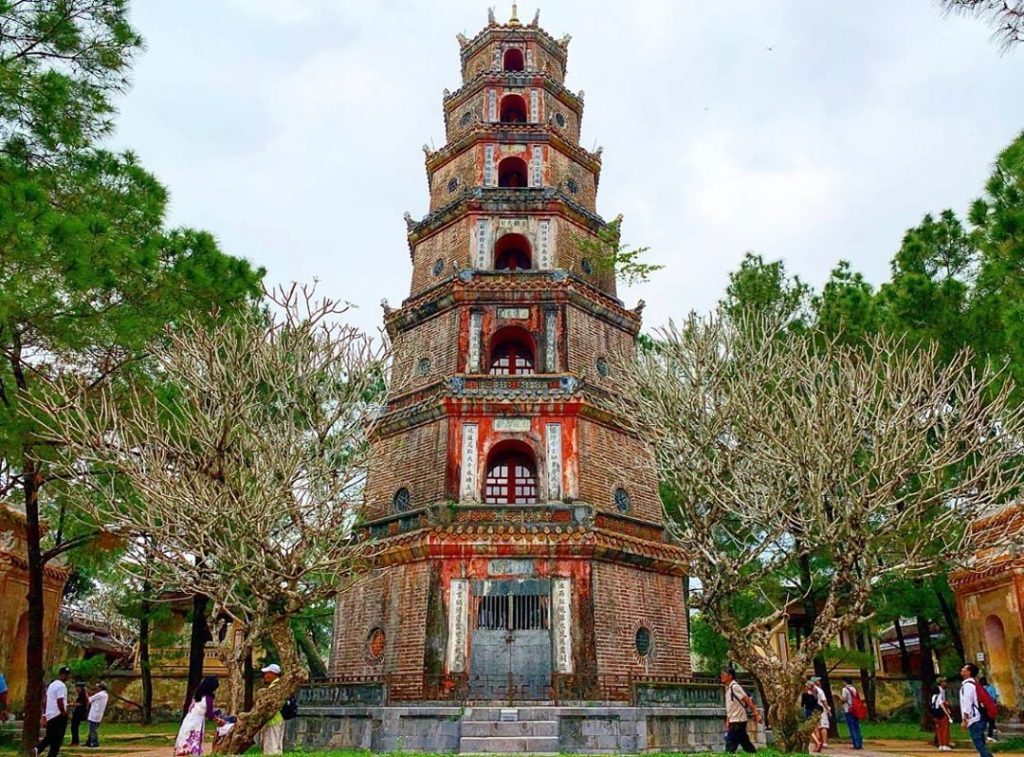
At the same time, locals shared a story about an old woman dressed in red, with a benevolent face. Each night, she would climb Ha Khue Hill and tell people that a true lord would establish a pagoda there to protect the land’s spiritual veins. Seeing a connection between his vision and the story, Nguyen Hoang immediately ordered his soldiers to build a pagoda on the hill. It was named “Thien Mu Tu” or “Pagoda of the Celestial Lady”.
Over time, the pagoda has undergone several renovations, the most notable being in 1710 during the reign of Lord Nguyen Phuc Chu. He completed and altered much of the architecture of Thien Mu Pagoda. Notably, a Great Bell weighing over 2 tons was cast and placed in the Dai Hung Shrine.
To this day, the pagoda remains worthy of its title as “The First Ancient Pagoda,” serving not only as a spiritual site but also as a beautiful landscape of the ancient capital. In addition to exploring destinations in Hue, choosing a place to stay for relaxation and recharging after each journey is also something you should consider.
Guide on How to Travel to Thien Mu Pagoda, Hue
Directions to Thien Mu Pagoda
To catch a glimpse of Thien Mu Pagoda standing proudly by the Perfume River from Hue Imperial City, follow these directions: start from Dang Thai Than street, then turn left onto Yen Kieu street. Proceed further and turn left onto Le Duan street. At the roundabout, take the right turn onto Kim Long street. Continue for another 2km until you reach your destination.
Modes of Transportation to Thien Mu Pagoda
Tourism in Hue is well-developed, offering various transportation options:
- Motorbike: Tourist attractions in Hue are not far apart. Moving around by motorbike gives you flexibility in destination and time. You can rent a motorbike daily from your hotel, typically costing between 100,000 to 250,000 VND per day.
- Private Car: If you seek a private, fast, safe, and comprehensive tour of multiple sites, consider booking a private car transfer service with Hue Transfer Service. Their local drivers, with years of experience serving international guests, ensure you have the best travel experience in Hue.
- Taxi: With Thien Mu Pagoda just 5km from the city center, taking a taxi is a convenient and time-saving option. Before hiring a taxi, check the fare rates in Hue to avoid overpaying.
- Motorbike Taxi (Xe ôm): If you prefer not to drive but want a more affordable option than a taxi, consider hiring a motorbike taxi to Thien Mu Pagoda. The ride-hailing services in Hue are also well-developed, making it easy to find and catch a ride quickly.
Opening Hours and Ticket Prices for Thien Mu Pagoda, Hue
- Opening Hours: All day
- Admission Fee: Free
If you’re planning your budget for this trip to Hue and wondering about the ticket prices for Thien Mu Pagoda, worry not! The pagoda is open to visitors free of charge every day of the week, welcoming tourists, Buddhists, and sightseers alike.
Exploring Thien Mu Pagoda, Hue
Contemplating the Serene and Poetic Beauty of Thien Mu Pagoda
Thien Mu Pagoda in Hue sits gracefully on the poetic banks of the Perfume River, adorned with a tranquil and serene beauty. From afar, visitors witness the ancient pagoda, resembling a giant turtle carrying on its back the venerable tower. The pagoda’s solemn presence reflects upon the Perfume River, creating a nostalgic atmosphere. The surroundings are painted with subtle hues, full of poetic essence found nowhere else. Stepping here, visitors enter a realm of tranquility and peace.
Thien Mu Pagoda is enveloped by graceful pine trees, ornamental plants, and delicate lotus ponds. The scent of lotus blooms fills the air. Leaving behind the hustle and bustle outside, here one hears only the slow footsteps, the gentle rustle of leaves, sometimes the clear sound of a resonant bell or the echo of wooden fish from the main hall… all creating a solemn Buddhist space, serene and profound. The picturesque and peaceful scenery here makes visitors linger, unwilling to leave.
Admiring the Ancient Architecture of Thien Mu Pagoda
Thien Mu Pagoda Map:

Every corner of Thien Mu Pagoda exudes a poetic and aesthetic charm that surprises visitors. Let’s explore the distinctive features of the architecture and the picturesque scenery that have been immortalized in countless books and melodies!
Dai Hung Shrine
Located within the main hall of Thien Mu Pagoda, Dai Hung Shrine is dedicated to Buddha of Happiness – the deity symbolizing carefree joy. The statue of Buddha of Happiness portrays a gentle demeanor, large ears symbolizing deep wisdom, a large belly representing tolerance, and a kind smile. The shrine, entirely built from solid concrete and painted to resemble wood, evokes a sense of closeness and familiarity.
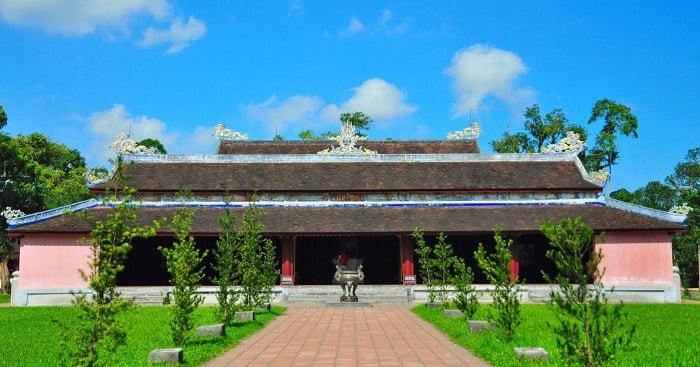
Dai Hung Shrine not only houses the Buddha of Happiness but also features a large self-portrait dating back to 1974 and an exquisite bronze bell in the shape of a sun and moon. Deep inside the shrine is the burial place of Master Thich Don Hau – the abbot of the pagoda.
Phuoc Duyen Tower
Phuoc Duyen Tower is a must-visit landmark when exploring Thien Mu Pagoda in Hue. This structure, built immediately after the gateway area, is often referred to as the “soul” of the pagoda. Along with other structures, it forms a cohesive complex that retains a unique and distinctive Hue character.
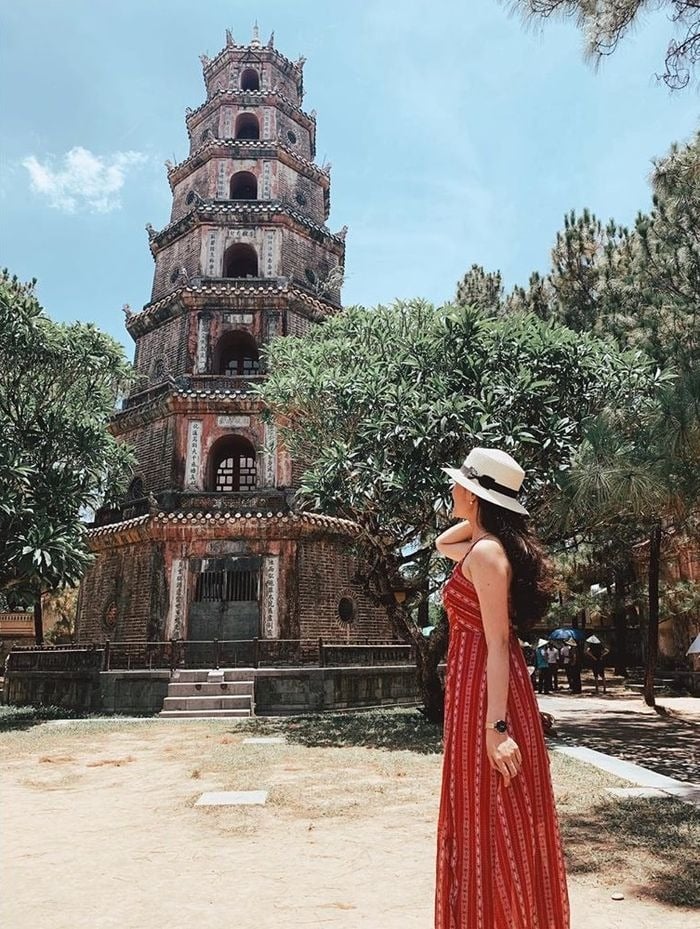
Constructed in 1844 by King Thieu Tri, Phuoc Duyen Tower was initially named Tu Nhan Tower, later changed to its current name. To complete the tower, materials such as clay, blue stone, and Bat Trang ceramics had to be transported from outside.
The tower’s body is constructed from wooden bricks, while the perimeter is built from blue stone. Together, they form an octagonal tower structure, tapering as it rises with seven floors, each 2 meters high. Overall, each floor is identically designed and painted pink. Over the years, it has acquired a “time-worn” appearance, enhancing the unique value of ancient imperial architecture.
Hoang Thanh Temple of Abbot Thich Don Hau
Hoang Thanh Temple of Abbot Thich Don Hau is a renowned figure at Thien Mu Pagoda in Hue. He dedicated his life to the development of Vietnamese Buddhism, earning respect for his numerous charitable activities. Upon his passing, local residents and the temple’s management buried him under a tower located at the end of the temple grounds as a gesture of gratitude to the venerable monk.
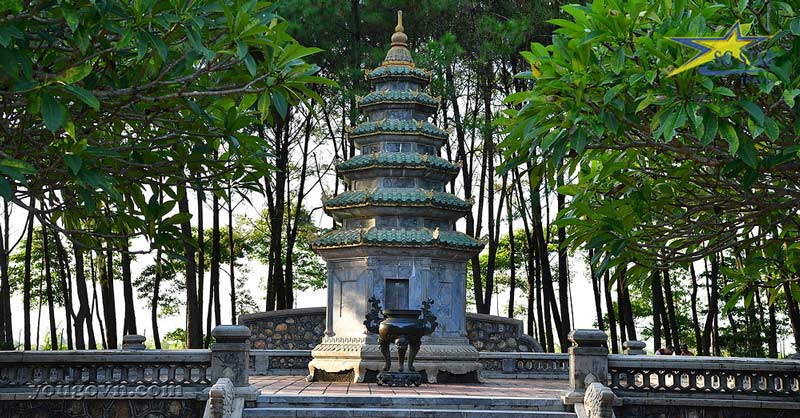
Dia Tang Hall
Located just behind Dai Hung Shrine, Dia Tang Hall offers a peaceful and tranquil ambiance. In front lies a spacious courtyard with lush greenery and a cool water pond, making it an interesting stop in your exploration of Thien Mu Pagoda in Hue.
[Image of Dia Tang Hall]Tam Quan Gate
This is the main entrance and exit of the pagoda, located behind Phuoc Duyen Tower. The gate has three entrances symbolizing the three realms: Human, Demon, and Divine. Designed with two floors and eight roofs, the middle gate’s second floor houses a Buddha altar. The roofs are adorned with unique floral patterns. The sides of the entrance are guarded by Hau Phap statues.
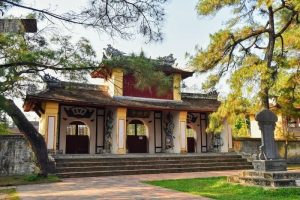
Listening to the True and False Stories of Curses Surrounding Thien Mu Pagoda
The formation and development of Thien Mu Pagoda in Hue are intertwined with many mystical legends passed down through generations, most notably the story of “karmic love”.
Legend has it that in this region, there was a couple deeply in love. Unfortunately, societal norms of that time did not accept a poor young man marrying a noblewoman from the aristocracy. Facing such adversity, the lovers chose to drown themselves in the Perfume River. They believed that “if we cannot live together, we shall die together,” but only the young man perished, while the girl was rescued and brought ashore by local villagers.
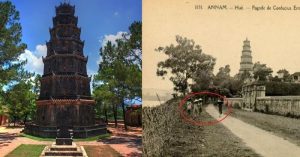
The pain of lost love for the girl gradually healed over time. Meanwhile, the young man waited for her under the moonlit night but never saw her again. His resentment led him to “enter” Thien Mu Pagoda. Since then, it has been rumored that “any loving couple who comes here will not have a happy ending”. This curse, still unbroken to this day, adds to the pagoda’s sanctity and mystery.
Regarding this legend, the current abbot of Thien Mu Pagoda clarifies: in reality, this story is embroidered to caution couples from taking advantage of the pagoda’s secluded corners for inappropriate behavior, which would disrespect its solemnity and tranquility. Therefore, this curse is entirely fictional. Nonetheless, visitors are encouraged to maintain respectful attitudes during their visit to preserve the pagoda’s beauty and value.
Note When Visiting Thien Mu Pagoda
To make your trip more complete, don’t forget the following tips!
- Attire: When visiting Thien Mu Pagoda in Hue, or any temple for that matter, modest and respectful attire is highly valued. Avoid wearing skirts or excessively short clothing, as it may seem inappropriate when visiting a temple. Additionally, choose clothing colors that complement the temple’s ambiance for better photographs!
- Speech: In the serene and quiet space, loud laughter and noisy conversations can make you appear disrespectful to other visitors. Therefore, strive to maintain order, walk calmly without pushing, to ensure respect within the Buddha’s precinct.
- Bring Water: There are no food or beverage services inside the pagoda. Therefore, bring water and some light snacks. After use, remember to dispose of trash in designated areas!
Thien Mu Pagoda in Hue remains a memorable destination for countless travelers from all corners of the globe. It not only showcases architectural beauty, historical significance, and style but is also adorned with the reserved and modest character of the people of Hue.
Through this article, we hope you now know where Thien Mu Pagoda in Hue is located, its points of interest, and can have unforgettable experiences in the ancient capital of Hue. It would be truly complete and meaningful if you could experience 5-star services with your friends or family right here in Hue.
